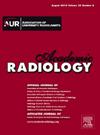基于超声放射组学和临床病理特征的神经网络和Logistic回归模型预测甲状腺乳头状癌隐匿II级淋巴结转移。
IF 3.8
2区 医学
Q1 RADIOLOGY, NUCLEAR MEDICINE & MEDICAL IMAGING
引用次数: 0
摘要
理由和目的:甲状腺乳头状癌(PTC)经常转移到颈部外侧淋巴结,特别是在II级。本研究旨在建立II级淋巴结转移(LNM)的预测模型,指导低危患者进行选择性颈部清扫(SND),以减少不必要的手术和发病率。方法:对2020年10月至2023年1月期间接受改良根治性颈部清扫术(MRND)的313例PTC患者进行回顾性队列分析。患者被随机分配到训练组(70%)和验证组(30%)。基于超声放射学特征、临床病理数据或两者的结合,使用神经网络(NNET)和逻辑回归(LR)开发了五种预测模型。每个模型的性能根据准确度、受试者工作特征曲线下面积(AUC)、敏感性和预测隐匿性II级LNM的特异性进行评估。SHapley加性解释和模态图被用来解释模型中最重要的特征。结果:队列中II级LNM发生率为28%。5个预测模型中,LR-radiomics特征模型的准确率最高,达到96.8%,AUC为0.989。相比之下,NNET-radiomic +临床特征模型的AUC为0.935,而其他模型的准确度为中至低,AUC范围为0.699至0.785。决策曲线分析表明,lr放射组学特征模型提供了最大的临床效用,在识别隐匿性II级LNM的决策阈值范围内提供了最高的净收益。结论:我们的研究利用超声衍生的放射学特征和临床病理数据建立了预测模型,以评估PTC隐匿性II级LNM的风险。lr -放射组学特征模型显示出很高的准确性,使其成为指导个性化治疗决策的宝贵工具,通过为高风险患者提供MRND信息,为低风险患者提供SND支持,以最大限度地减少不必要的手术干预并优化临床结果。本文章由计算机程序翻译,如有差异,请以英文原文为准。
Neural Network and Logistic Regression Models Based on Ultrasound Radiomics and Clinical-Pathological Features to Predict Occult Level II Lymph Node Metastasis in Papillary Thyroid Carcinoma
Rationale and Objectives
Papillary thyroid carcinoma (PTC) often metastasizes to lateral cervical lymph nodes, especially in level II. This study aims to develop predictive models to identify level II lymph node metastasis (LNM), guiding selective neck dissection (SND) to minimize unnecessary surgery and morbidity in low-risk patients.
Methods
A retrospective cohort of 313 PTC patients who underwent modified radical neck dissection (MRND) between October 2020 and January 2023 was analyzed. The patients were randomly assigned to a training cohort (70%) and a validation cohort (30%). Five predictive models were developed using neural networks (NNET) and logistic regression (LR) based on ultrasound radiomic features, clinical-pathological data, or a combination of both. Each model’s performance was evaluated based on accuracy, area under the receiver operating characteristic curve (AUC), sensitivity, and specificity in predicting occult level II LNM. SHapley Additive exPlanations and nomogram were used to interpret the most important features in the models.
Results
The occurrence rate of level II LNM was 28% in the cohort. Among the five predictive models developed, the LR-radiomics signature model demonstrated the highest performance, achieving an accuracy of 96.8% and an AUC of 0.989 in the validation set. In comparison, the NNET-radiomic + clinical feature model achieved an AUC of 0.935, while other models exhibited moderate to low accuracy and AUCs ranging from 0.699 to 0.785. The decision curve analysis demonstrated that the LR-radiomics signature model provided the greatest clinical utility, offering the highest net benefit across a range of decision thresholds for identifying occult level II LNM.
Conclusion
Our study developed predictive models using ultrasound-derived radiomic features and clinical-pathological data to assess the risk of occult level II LNM in PTC. The LR-radiomics signature model demonstrated high accuracy, making it a valuable tool for guiding personalized treatment decisions, by informing MRND for high-risk patients and supporting SND for low-risk patients to minimize unnecessary surgical interventions and optimize clinical outcomes.
求助全文
通过发布文献求助,成功后即可免费获取论文全文。
去求助
来源期刊

Academic Radiology
医学-核医学
CiteScore
7.60
自引率
10.40%
发文量
432
审稿时长
18 days
期刊介绍:
Academic Radiology publishes original reports of clinical and laboratory investigations in diagnostic imaging, the diagnostic use of radioactive isotopes, computed tomography, positron emission tomography, magnetic resonance imaging, ultrasound, digital subtraction angiography, image-guided interventions and related techniques. It also includes brief technical reports describing original observations, techniques, and instrumental developments; state-of-the-art reports on clinical issues, new technology and other topics of current medical importance; meta-analyses; scientific studies and opinions on radiologic education; and letters to the Editor.
 求助内容:
求助内容: 应助结果提醒方式:
应助结果提醒方式:


